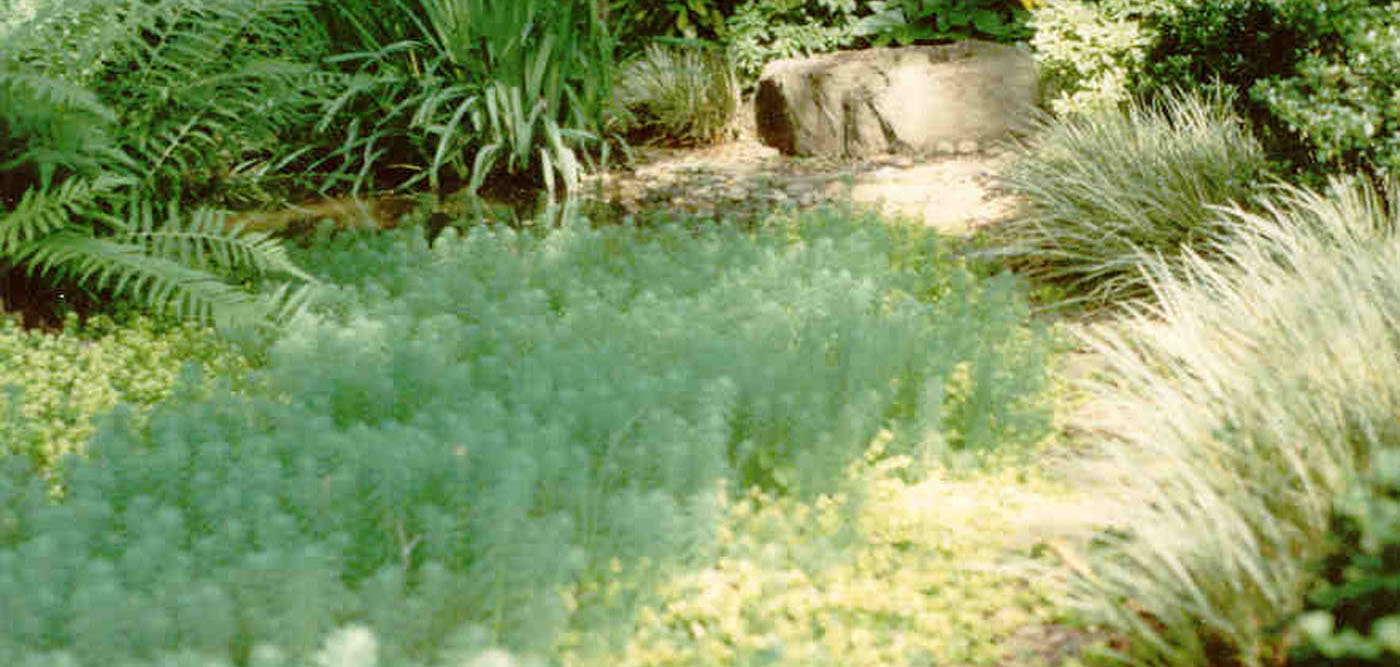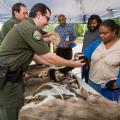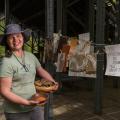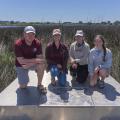Easy Groundcovers for Mississippi Lawns

Groundcovers serve many important functions in the home landscape. These low growing plants control soil erosion, reduce glare and heat, slow and absorb rainwater run-off, compete against weeds, muffle sounds, and help to direct pedestrian traffic.
In the design of the home landscape, groundcovers define the ground plane and provide interesting combinations to traditional turf and paving. A use of a solid groundcover unifies individual plantings of shrub and tree groupings and defines planting beds and boundaries. A variety of groundcovers also provides visual contrasts of color, texture, and pattern with other nearby materials.
Groundcovers are typically low growing plants less than three feet in height. They may be evergreen or deciduous, and can be creeping, clump-forming, trailing, or prostrate in form. There is a wealth of plants suited for groundcover use in Mississippi, and varieties should be selected according to the amount of sun or shade available in the desired area. In areas that are too shady for lawn grass to properly grow, such as under the dense shade of oak or magnolia trees, shade-loving groundcovers are the perfect choice.
Designing with Groundcovers
The first step in establishing groundcovers is to determine the bed shape and size. The size of the groundcover area should be in proportion (i.e. 'looks right') to the surrounding vegetation types and available garden space. Plants that vine, such as asian jasmine or vinca, will need bed edging to contain their sprawling stems. Choose bed edging materials and forms that best complement the design and character of the home and surrounding paving types.
Establishing a Groundcover Bed
If lawn grass or weeds are growing in the groundcover area, use an herbicide to control existing vegetation (read the product label for application and use). Add any soil amendments needed and till the ground several inches (avoid injuring nearby tree roots) to loosen the soil. For sunny or problem weed areas, it is best to use a permeable weed fabric to reduce unwanted vegetation. Add a thick layer of mulch (at least 2" of pine straw, bark, gravel, stone, or wood chips) on top of the weed fabric to reduce soil temperatures and to moderate moisture. To plant, simply move the mulch and slice the fabric in an 'x' fashion about 6 inches long. Fold in the fabric edges to dig the planting hole.
The quantity of groundcover plants needed depends upon the types of plants to be selected and the amount of bed space to cover. Plants that vine will cover larger areas over time. Clump-forming plants such as liriope or monkeygrass will need to be planted closer together to fully vegetate the zone. Calculate the total bed area to be planted by determining the bed's square footage, then divide this amount by the square footage of each plant at maturity.
Maintenance
During the first year, new plantings will need some weeding and watering to establish. For quicker coverage, fertilize in early spring with a complete fertilizer such as 13-13-13 or 10-10-10. Recommended rates are two pounds per 100 square feet of bed, and apply when the foliage is dry.
The following table lists a variety of recommended durable groundcovers and their growth characteristics.
|
Groundcover |
Foliage |
Exposure |
Size |
Remarks |
|---|---|---|---|---|
|
Bugleweed, |
Deciduous |
Shade |
3"-6" |
Requires well-drained soil, |
|
Cast iron plant, |
Evergreen |
Shade |
30"-36" |
Coarse leaf texture, |
|
Holly fern, |
Evergreen |
Shade |
24"-30" |
Clump forming perennial, |
|
English ivy, |
Evergreen |
Shade |
30'-40' |
Climbing vine, |
|
Liriope, |
Evergreen |
Sun/shade |
12"-18" |
Grass-like clump perennial, |
|
Moneywort, |
Deciduous |
Sun/part sun |
3" x18" |
Yellow-green foliage, |
|
Monkey grass, |
Evergreen |
Sun/shade |
8"-8" |
Grass-like clump perennial, |
|
Stonecrop, |
Evergreen |
Sun |
4"x12" |
Creeping groundcover, |
|
Asian jasmine, |
Evergreen |
Sun/shade |
12"x10' |
Vining perennial, |
|
Periwinkle, |
Evergreen |
Part shade |
12"x3' |
Vining perennial |
|
Littleleaf periwinkle, |
Evergreen |
Part shade |
10"x3' |
Vining perennial, |
|
Daylily, |
Evergreen/Deciduous |
Sun |
36"x36" |
Clump perennial |
|
Wild ginger, |
Evergreen |
Shade |
4"x6" |
Heart shape leaf, |
|
Confederate jasmine, |
Evergreen |
Sun |
12"x10' |
White spring flowers |
|
Ardisia, |
Evergreen |
Shade |
24"x24" |
Red winter fruit |
|
Japanese ardisia, |
Evergreen |
Shade |
10"x10" |
Red winter fruit |
|
Butterfly iris, |
Herbaceous |
Sun |
24"x24" |
Clump perennial |
|
Louisiana iris, |
Evergreen |
Sun |
36"x36" |
Clump perennial |
|
Indigo, |
Deciduous |
Part shade |
24"x24" |
Spreading shrub |
|
|
||||
Publications may download photo at 200 d.p.i.
These factsheets were written by Robert F. Brzuszek, Assistant Extension Professor, The Department of Landscape Architecture, Mississippi State University.
Publications
News
An underserved community spent a day enjoying the outdoors at the Sam D. Hamilton Noxubee National Wildlife Refuge in early May as Mississippi State University Extension Service personnel hosted 20 adult residents of care homes.
Jim McAdory, MSU Extension agent in Winston County, coordinated the May 1 event with help from several other Extension agents and U.S. Fish and Wildlife Service staff. The goal was to allow this population to experience the outdoors, complete with a hot dog lunch at the end of the event.
PICAYUNE, Miss. -- School groups, nature enthusiasts and the public can enjoy two fun-filled days of exciting, hands-on learning about the environment, ecosystems, wildlife and insects at the Mississippi State University Crosby Arboretum in Picayune. BugFest offers insect-related displays, interactive exhibits, games and crafts. Biologists, naturalists, entomologists and other experts from Mississippi, Louisiana and Alabama will host booths and give presentations on butterflies, bats, caterpillars, beetles, crayfish, ladybugs, hissing cockroaches, dancing praying mantises, native and exotic arthropods and more.
Two conservation camps this summer offer students in grades six through 12 the opportunity to gain hands-on experience in wildlife science, outdoor recreation and conservation careers. Conservation Camp 2022 has a residential edition June 5-8 for rising eighth through 12th graders. The day camp edition is June 13-15 for rising sixth through eighth graders.
Success Stories
More than 80 grade-school students from Choctaw Tribal Schools visited Mississippi State University in March to participate in Choctaw Preview Day.
Robin Whitfield, who gave the child the paper, stands awestruck, watching her friend’s daughter use the flower to draw and color on the page.
Mississippi State University and partners have been awarded a grant of nearly $6.6 million from the National Fish and Wildlife Federation for shoreline restoration work on the Gulf Coast.





